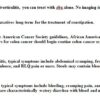Description
NR 511 Final Exam Study Guide
NR 511 Week 2
- Identify the most common type of pathogen responsible for acute gastroenteritis
- Recognize that assessing for prior antibiotic use is a critical part of the history in patients presenting with diarrhea
- Describe the difference between Irritable Bowel Disease (IBS) and Inflammatory Bowel Disorder (IBD)
- Discuss two common Inflammatory Bowel Diseases
- Discuss the diagnosis of diverticulitis, risk factors, and treatments
- Identify the significance of Barrett’s esophagus
- Discuss the diagnosis of GERD, risk factors, and treatments
- Discuss the differential diagnosis of acute abdominal pain, work-up and testing, treatments
- Discuss the difference between sensorineural and conductive hearing loss
- Identify the triad of symptoms associated with Meniere’s disease (tinnitus, vertigo, and hearing loss)
- Identify the symptoms associated with peritonsilarabcess
- Identify the most common cause of viral pharyngitis
- Identify the most common cause of acute nausea & vomiting
- Discuss the importance of obtaining an abdominal xray to rule out perforation or obstruction even though the diagnosis of diverticulitis can be made clinically
- Discuss colon cancer screening recommendations relative to certain populations
- Identify at least two disorders that are considered to be disorders related to conductive hearing loss
- Identify the most common bacterial cause of pharyngitis
- Identify the clinical findings associated with mononucleosis
- Identify common characteristics in a rash caused be Group A Strep
- Discuss that the diagnosis of streptococcal pharyngitis can be made clinically based on the Centor criteria
- Describe an intervention for a patient with gastroenteritis
- Discuss an appropriate treatment for prophylaxis or treatment of traveler’s diarrhea
- Identify at least one effective treatment for Irritable Bowel Syndrome (IBS)
- Identify at least one prescription medication for the treatment of chronic constipation
- Discuss at least one treatment for Meniere’s disease
NR 511 Week 3
- Discuss that the majority of dyspnea complaints are due to cardiac or pulmonary decompensation
- Explain the differences between intra-thorax and extra-thorax flow disorders
- Identify at least three examples of flow and volume disorders (intra and/or extra thorax)
- Discuss diagnosis, risk factors and treatments for asthma
- Describe appropriate tests in the work up for dyspnea
- Discuss clinical findings and PFTs for asthma, chronic bronchitis, emphysema, and COPD
- Differentiate between the following common rashes: rubeola, rubella, varicella, roseola, 5ths disease, pityriasisrosea, hand, foot and mouth disease and molluscumcontagiosum.
- Differentiate between the following tineas: pedis, cruris, corporis and unguium and describe an appropriate treatment
- Identify the virus that causes warts
- Differentiate between atopic and contact dermatitis and give examples of each
- Identify common characteristics associated with blepharitis, chalzion and hordeolum
- Differentiate between viral, allergic, bacterial, toxic and HSV conjunctivitis
- Discuss which chemical injury is associated with the most damage and highest risk to vision loss
- Recognize common eye emergency conditions that require emergency room evaluation
- Discuss glaucoma, diagnosis and treatment
- Discuss diabetic retinopathy







